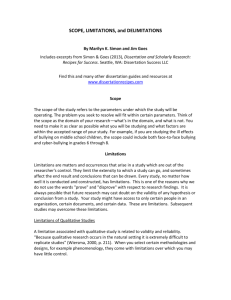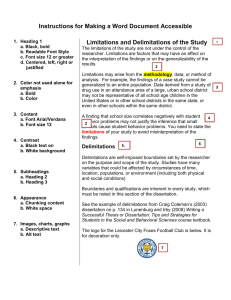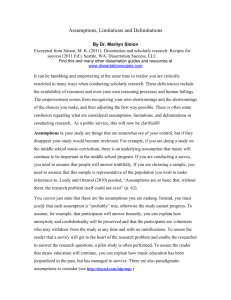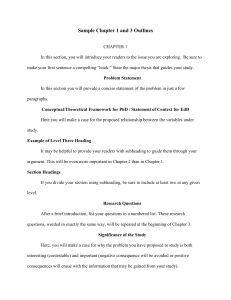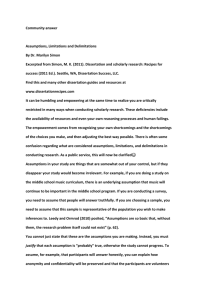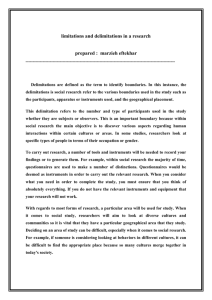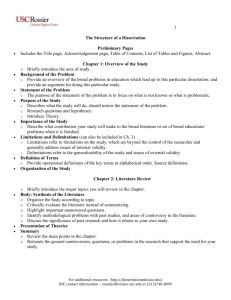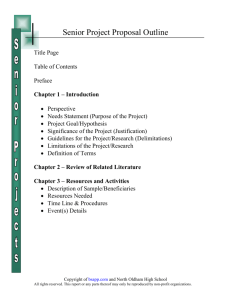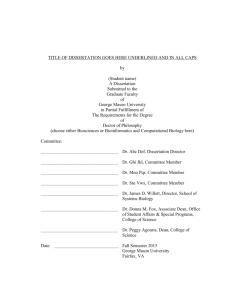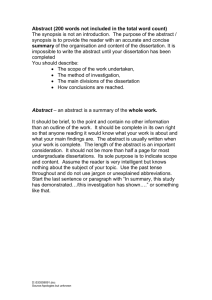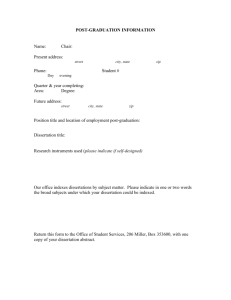Assumptions, Limitations, Delimitations, and Scope of the Study By
advertisement
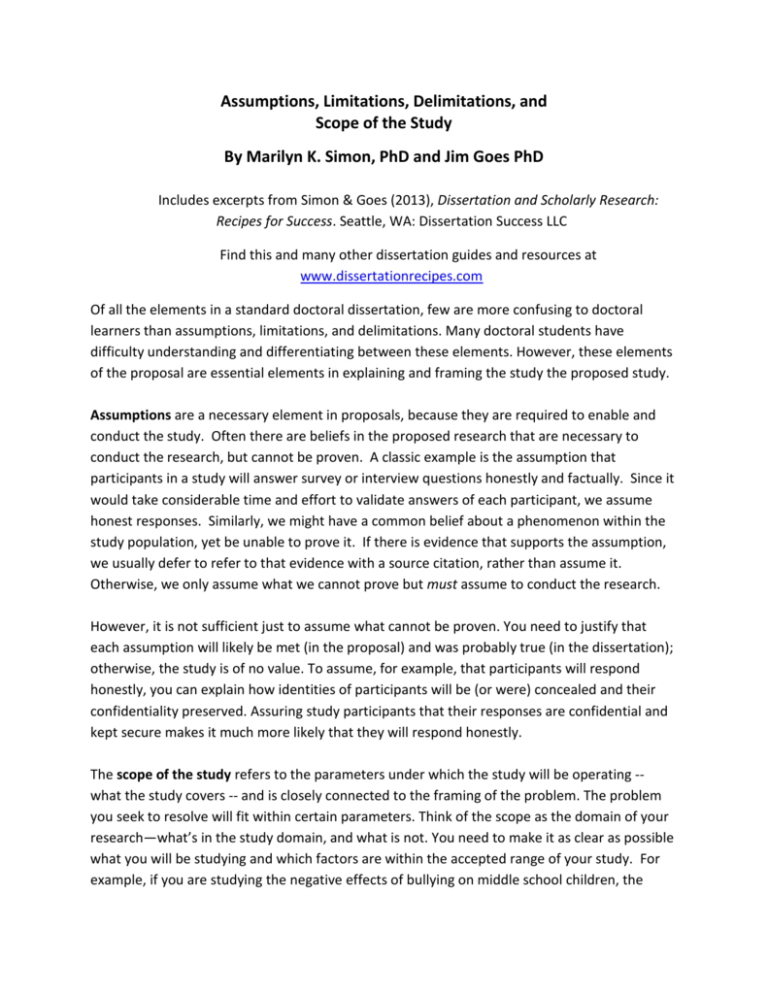
Assumptions, Limitations, Delimitations, and Scope of the Study By Marilyn K. Simon, PhD and Jim Goes PhD Includes excerpts from Simon & Goes (2013), Dissertation and Scholarly Research: Recipes for Success. Seattle, WA: Dissertation Success LLC Find this and many other dissertation guides and resources at www.dissertationrecipes.com Of all the elements in a standard doctoral dissertation, few are more confusing to doctoral learners than assumptions, limitations, and delimitations. Many doctoral students have difficulty understanding and differentiating between these elements. However, these elements of the proposal are essential elements in explaining and framing the study the proposed study. Assumptions are a necessary element in proposals, because they are required to enable and conduct the study. Often there are beliefs in the proposed research that are necessary to conduct the research, but cannot be proven. A classic example is the assumption that participants in a study will answer survey or interview questions honestly and factually. Since it would take considerable time and effort to validate answers of each participant, we assume honest responses. Similarly, we might have a common belief about a phenomenon within the study population, yet be unable to prove it. If there is evidence that supports the assumption, we usually defer to refer to that evidence with a source citation, rather than assume it. Otherwise, we only assume what we cannot prove but must assume to conduct the research. However, it is not sufficient just to assume what cannot be proven. You need to justify that each assumption will likely be met (in the proposal) and was probably true (in the dissertation); otherwise, the study is of no value. To assume, for example, that participants will respond honestly, you can explain how identities of participants will be (or were) concealed and their confidentiality preserved. Assuring study participants that their responses are confidential and kept secure makes it much more likely that they will respond honestly. The scope of the study refers to the parameters under which the study will be operating -what the study covers -- and is closely connected to the framing of the problem. The problem you seek to resolve will fit within certain parameters. Think of the scope as the domain of your research—what’s in the study domain, and what is not. You need to make it as clear as possible what you will be studying and which factors are within the accepted range of your study. For example, if you are studying the negative effects of bullying on middle school children, the scope of the study could include both face-to-face bullying and cyber-bullying in grades 6 through 8, but exclude other grades. Limitations are constraints that are largely beyond your control but could affect the study outcome. Limitations often flow from methodology and study design choices. Each different option in methodology and study design has particular limitations. These limit the extensity to which a study can go, and sometimes affect the end result and conclusions that can be drawn. Every study, no matter how well it is conducted and constructed, has limitations. These limitations relate to the specifics of each methodology and design, and force the researcher into tradeoffs. This is one of the reasons why we do not use the words "prove" and "disprove" with respect to research findings. It is always possible that future research may cast doubt on the validity of any hypothesis or conclusion from a study, particularly if conducted using a different methodology or design. Your study might have access to only certain people in an organization, certain documents, and certain data. These are limitations. Subsequent studies may overcome these limitations. Limitations of Qualitative Studies A limitation associated with qualitative study is related to validity and reliability. “Because qualitative research occurs in the natural setting it is extremely difficult to replicate studies” (Wiersma, 2000, p. 211). When you select certain methodologies and designs, for example phenomenology, you accept inherent limitations over which you may have little control. Limitations of Case Studies We cannot make causal inferences from case studies, because we cannot rule out alternative explanations. It is always unclear about the generality of the findings of a case study. A case study involves the behavior of one person, group, or organization. The behavior of this one unit of analysis may or may not reflect the behavior of similar entities. Case studies may be suggestive of what may be found in similar organizations, but additional research would be needed to verify whether findings from one study would generalize elsewhere. This is one reason why case studies tend to be used for poorly understood problems – there is a need for qualitative, inductive research to understand the problem, which may inform subsequent quantitative, deductive research and potentially generalizable results. Limitations of Correlational Studies Correlational research merely demonstrates that we can predict the behavior of one variable from the behavior of another variable. If a relationship exists then there is an association between variables. However, two variables can be associated without there being a causal relationship between the variables. If we find that X is associated with Y, it could mean that X caused Y, or Y caused X, or some “third” (confounding) variable caused both X and Y without there being any causal relationship between X and Y. Correlational research may also have limitations with respect to the generality of the findings. Perhaps the study involved a specific group of people, or that the relationship between the variables was only investigated under some situation or circumstance. Thus, it may be uncertain whether the correlational findings will generalize to other people or situations. Limitations of Randomized Experiments Experiments involving the random assignment of participants to conditions sometimes allow us to make causal conclusions if the variables that are manipulated are not confounded with other variables. Experiments gain rigor by controlling for influences outside of the variables of interest. However, there still may be limitations with respect to the generality of the findings. The experiment may have involved a specific group of people, certain situations, and only some of the possible conceptualizations of variables. Thus, we may not know whether the findings will generalize to other people, situations, or conceptualizations of the variables. Within particular bounds, significant findings from an experimental study may infer a general cause, but the presence of other unmeasured variables can limit the scope of that inference. Limitations of Survey Instruments Surveys that are distributed with time constraints were noted by Delva, Kirby, Knapper, and Birtwhistle (2002) as problematic in that people who struggle with real or perceived time constraints are less likely to respond to surveys because these possible respondents feel overworked – they just do not have the time to complete the survey. Surveys often also suffer the limitation of forcing respondents into particular response categories, thereby limiting the range of responses. Unlike an interview, where respondents can ask clarifying questions, respondents are usually limited to the text in the survey itself for direction about how to complete it and where to respond. The type of methodology selected has limitations regarding aspects such as generalizability. Researcher bias could potentially influence the approach and analysis of data. If you have extensive experience in the topic it is important to reveal this and explain steps to eliminat or reduce this bias. If the sample size is small, then generalizability is not possible. If standardized instruments are used then the information obtained is limited, in part, by the accuracy and applicability of the instrument selected. There can also be practical limitations such as time, money, accessibility, and human resources. If you plan to use a Likert-type scale, the different difference between agree and strongly agree could be irrelevant to the participant but could affect the study results. Delimitations The delimitations of a study are those characteristics that arise from limitations in the scope of the study (defining the boundaries) and by the conscious exclusionary and inclusionary decisions made during the development of the study plan. Unlike limitations, which flow from implicit characteristics of method and design, delimitations result from specific choices made by the researcher. Among these are the choice of objectives and questions, variables of interest, theoretical perspectives that were adopted, the paradigm (qualitative, quantitative, or mixed), the theoretical framework, and the choice of participants. The first delimiting step is the choice of problem, implying that there were other, related problems that could have been chosen but were rejected or screened off from view. To elucidate the delimitations of your study you should review each decision you had to make in putting together your study. In your purpose statement you declare what your study is intended to accomplish. In the delimitations section you can repeat this declaration along with a pronouncement of what the study is not intended to cover. In the latter case, your decisions for excluding certain pursuits are likely based on such criteria as not directly relevant; too problematic because…; not feasible and the like. Make this reasoning as explicit as possible. References Delva, M. D., Kirby, J. R., Knapper, C. K. & Birtwhistle, R. V. (2002). Postal survey of approaches to learning among Ontario physicians: Implications for continuing medical education. British Medical Journal, 325, 1218-1222. Wiersma, W. (2000). Research methods in education: An introduction. Boston, MA. Allyn and Bacon.
